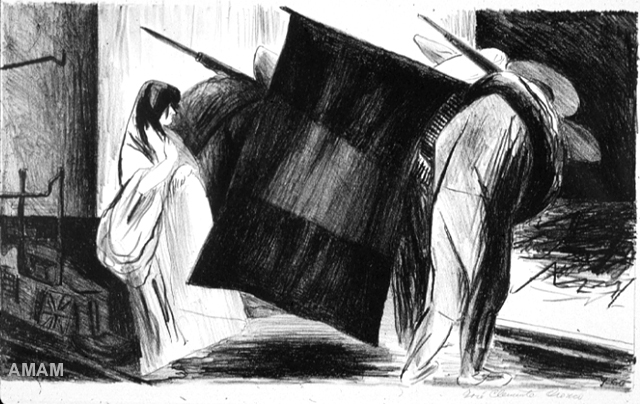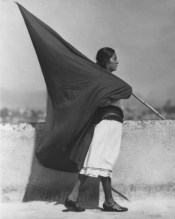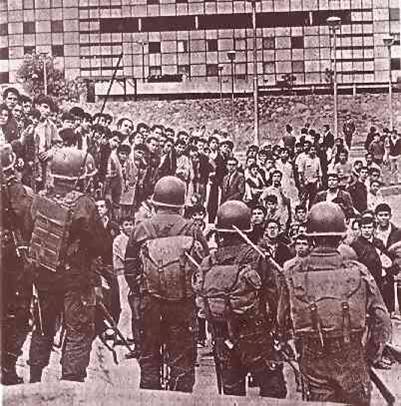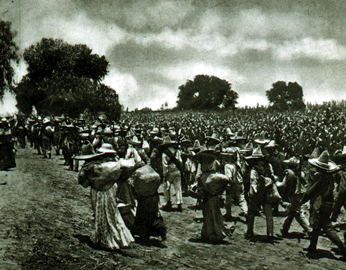
José Clemente Orozco, "The Flag" (1928) - Allen Memorial Art Museum (Oberlin, OH)
Mr. Volk
Classroom: King 335 (Tuesday 7:00-9:00 PM)
Office: Rice 309; Phone: x5-8522; Email: Steven.Volk@oberlin.edu
Office Hours: Monday 2-3 PM; Wednesday 10-11 AM; Friday 1:30-2:30 PM, and by
appointment.

José Clemente Orozco, "The Flag" (1928) - Allen
Memorial Art Museum (Oberlin, OH)
ACCESSING COURSE MATERIALS: Course materials can be found on the Blackboard
system. This electronic bulletin board will post, the syllabus, paper assignments,
and some reading materials as well as visual materials useful for the course.
The Mexican Revolution is one of a handful of monumental social, political and
cultural movements which shaped the 20th century landscape. Along with the Russian
and the Chinese revolutions (and, to a lesser extent, the Cuban), the Mexican
Revolution has generated a massive amount of historical writing, film, art,
literature, and music. Perhaps not surprisingly, historians and other social
scientists disagree about nearly every aspect of the revolution, from when it
began to whether it actually ever took place.
The purpose of this seminar is to introduce you to some aspects of the historiography of the critical set of events that comes to be known as the "Mexican Revolution." The basic organizing device for the course is historiographic chronology - not the chronology of the Mexican Revolution itself (e.g., tracing the course of the revolution from the 1910s, through succeeding decades), but the chronology of its historiography, literature, and artistic production. In a relatively chronological fashion, we will trace the work of those who wrote about, produced films on, or studied the history of the Mexican Revolution from the vantage point of when they produced their work, suggesting that their (and our) understanding of the revolution is not just dependent on the availability and depth of its archives (what kind of documentation do we have?), but on its context which shapes its analysts. In that sense, the prevalent interpretations of the revolution change over time, from more hopeful initial stages in the 1920s and 1930s, to much gloomier perspectives in the 1960s and, particularly, after the Plaza de Tlatelolco massacre in 1968. Because we are following the historiographic chronology, the course will have occasion to circle back on itself, covering historical events we seem already to have traversed, in order to locate new interpretations and arguments.
In that sense, this is a course about Mexico and the Mexican Revolution (i.e., about "history"), but just as importantly, it is a course about the narrativization of historical subjects (i.e., about "History").
This presents me with an immediate difficulty as to how to begin the course. While many of you will have taken History 110 and will have a good background in Mexican history, others haven't. And even those who have taken 110 may not have the best background on the Mexican Revolution. My normal solution would be to assign a general, and relatively short text on the topic so that you can get up to speed. But, of course, this class is designed to underline the point that writing about the Mexican Revolution is very much shaped, if not fully determined, by its location within ongoing historiographic debates. Thus, to privilege one text as "authoritative" seems to defeat the purpose of the course. With that said, I would still recommend some books for those who have not studied Mexican history and/or want to begin with a general overview of the revolution so that, at the least, chronologies, names, places, and events can begin to take shape.
For books specifically on Mexico:
Alicia Hernández Chávez, Mexico: A Brief History, Andy Klatt, trans. (Berkeley and Los Angeles: University of California Press), 2006. While not exactly brief, this new edition is the best available. The sections on independent Mexico and the Revolution are around 150 pages.
Other possibilities:
Brian R. Hamnett, A Concise History of Mexico (Cambridge and NY: Cambridge University Press), 1999.
Héctor Aguilar Camín and Lorenzo Meyer, trans. Luís Alberto Fierro, In the Shadow of the Mexican Revolution: Contemporary Mexican History, 1910-1989 (Austin: University of Texas Press), 1993.
Michael C. Meyer, William Sherman, and Susan Deeds, The Course of Mexican History, 7th ed. (NY: Oxford University Press), 2003. [Anything but concise, at 742 pgs.]
For good textbook coverage of Latin America, from which you could read the chapter/s on Mexico:
Thomas E. Skidmore and Peter H. Smith, Modern Latin America, 6th ed. (NY: Oxford University Press), 2005.
John Charles Chasteen, Born in Blood and Fire: A Concise History of Latin America, 2nd ed. (NY: W.W. Norton), 2006.
For those who want to being by reading any history of the Mexican Revolution, just so you can get the names, dates, and places straight (and keeping in mind that every history will have a specific perspective):
Michael J. Gonzales, The Mexican Revolution, 1910-1940 (Albuquerque: University of New Mexico Press), 2002.
Adolfo Gilly, The Mexican Revolution: A People's History (NY: New Press), 2006 [1971].
Ramon Ruíz, The Great Rebellion. Mexico 1905-1924 (NY: W.W. Norton), 1980.
Assignments:
Weekly: We will discuss the nature of the assignments during the first class. What follows is the model I typically use for seminars:
Four students will be in charge of each class session. Two of the four ("presenters") will write a short (3-5 page) paper addressing important analytic and/or historiographic issues raised in that week's readings or other materials (film, photography, art). This is not to be a summary of the reading, but rather an analytic paper. I will provide some guidance for these papers during the first session in terms of what I will be looking for. These two students will be responsible for posting the papers to the Blackboard by the Monday afternoon (no later than 6:00 PM) prior to each Tuesday evening's class at which point we will all discuss the readings. The other two students ("responders") will serve as formal respondents to the papers, summarizing the main points of the assigned paper and leading the general discussion.
All the other members of the class are required to bring discussion questions to class based on their reading. I will collect these questions at the beginning of class. You will be responsible for writing papers for two classes and serving as a respondent for an additional two classes. I will provide written feedback on all papers; respondents will get a check+, check, or check- for their ability to organize and lead the discussion, which will be factored into the final grade (see below).
Final Assignment: Your final assignment is a 15-20 page research paper on any subject covered in the course. Please note the dates in the syllabus when your research topic, first bibliography, and further elaboration of the topic are due.
Grades:
If you have a documented disability and wish to discuss academic accommodations, please contact me as soon as possible.
Required Reading: Recommended for Purchase.
We will either read these books entirely or large portions of them. They are on order at the Oberlin Bookstore, can be purchased on line (often Amazon.com has copies that are quite a bit cheaper than list price, and used copies that are cheaper still), or on reserve at the library. You can also get them at the appropriate time from OHIOLINK.
Mariano Azuela, The Underdogs: A Novel of the Mexican Revolution, trans. Jr. E. Munguia, intro. Ilan Stavans (New York: Modern Library), 2002 [1915].
Anita Brenner and George R. Leighton, The Wind that Swept Mexico: The History of the Mexican Revolution of 1910-1942 (Austin: University of Texas), 1984 [1943].
Rosario Castellanos, The Book of Lamentations, trans. Esther Allen, intro. Alma Guillermoprieto (NY: Penguin USA), 1998 [1962].
John Womack, Zapata and the Mexican Revolution (NY: Vintage), 1970 [1968].
Carlos Fuentes, The Death of Artemio Cruz (New York: Noonday Press), 1991 [1962].
Paco Ignacio Taibo II, An Easy Thing (Scottsdale, AZ: Poisoned Pen Press), 2002 [1990].
Eric Zolov, Refried Elvis: The Rise of the Mexican Counterculture (Berkeley and Los Angeles: University of California Press), 1999.
Katherine Elaine Bliss, Compromised Positions: Prostitution, Public Health, and Gender Politics in Revolutionary Mexico City (University Park, PA: Penn State University Press), 2002.
Zapata's soldiers breakfast at Sanborns, Mexico City, 1914
SYLLABUS
Feb. 6: Welcome to the Mexican Revolution
Michael J. Gonzales, The Mexican Revolution, 1910-1940 (Albuquerque: University of New Mexico Press, 2002), Introduction and Chapter 1 (pp. 1-59). (Available on Blackboard "Course Documents").
Feb. 13: Like a Leaf in the Wind
Mariano Azuela, The Underdogs: A Novel of the Mexican Revolution, trans. Jr. E. Munguia, intro. Ilan Stavans (Modern Library), 2002 [1915].
If you want to go further:
Martín Luís Guzmán, El águila y la serpiente (Madrid), 1928.
Agustín Vera, La revancha (San Luís Potosí), 1930.
Feb. 20: This Revolution Will be Photographed.
 Tina Modotti, "Woman with Flag," 1928 (Museum of Modern
Art, New York)
Tina Modotti, "Woman with Flag," 1928 (Museum of Modern
Art, New York)
Anita Brenner and George R. Leighton, The Wind that Swept Mexico: The History of the Mexican Revolution of 1910-1942 (Austin: University of Texas), 1984 [1943].
Photography of Tina Modotti [Selection of Tina Modotti photographs will be available on Blackboard, "Course Documents"]
If you want to go further:
Frank Tannenbaum, Peace by Revolution: An Interpretation of Mexico (NY: Columbia University Press), 1933.
Andrea Noble, Tina Modotti: Image, Texture, Photography (Albuquerque: University of New Mexico Press), 2000.
Feb. 27: The Revolution on the Walls: Muralists and Others
From Mary Kay Vaughan and Stephen E. Lewis, eds., The Eagle and the Virgin National and Cultural Revolution in Mexico, 1920-1940 (Durham: Duke University Press, 2006), the following:
Rick A. López, "The Noche Mexicana and the Exhibition of Popular Arts: Two Ways of Exalting Indianness" (23-42); [ERes and Regular Reserve]
Desmond Rochfort, "The Sickle, the Serpent, and the Soil: History, Revolution, Nationhood, and Modernity in the Murals of Diego Rivera, José Clemente Orozco, and David Alfaro Siqueiros" (43-57) [ERes and Regular Reserve]; and
Sarah M. Lowe, "Painting in the Shadow of the Big Three" (58-94) [ERes and Regular Reserve].Steven S. Volk, "Frida Kahlo Remaps the Nation," Social Identities 6:2 (June 2000): 165-188. [Also available in Blackboard, Course Documents]
We will be consulting some works at the Allen Art Museum and using the following
web sites for specific images:
Diego Rivera (1)
Diego Rivera (2) [Note: Scroll down]
José Clemente Orozco [Note: Scroll down]
David Alfaro Siqueiros [Note: Near bottom of page]
If you want to go further:
Shifra Goldman, Contemporary Mexican Painting in a Time of Change (Albuquerque: University of New Mexico Press), 1995.
Leonard Folgarait, Mural Painting and Social Revolution in Mexico, 1920-1940: Art of the New Order (New York: Cambridge University Press), 1998.
David Craven, Diego Rivera: An Epic Modernist (NY: G.K. Hall), 1997.
Antonio Rodríguez, David Alfaro Siqueiros: Mural Painting (Mexico, DF: Fondo Editorial de la Plástica Mexicana), 1992.
Hayden Herrera, Frida. A Biography of Frida Kahlo (NY: Harper & Row), 1983.
Margaret Hooks, Tina Modotti. Photographer and Revolutionary (NY: Da Capo Press), 2000.
Andrea Noble, Tina Modotti: Image, Texture, Photography (Albuquerque: University of New Mexico Press), 2000.
March 6: The Revolution in Film: The Fernando de Fuentes' Trilogy
Andrea Noble, "The Mexican Revolution as Moving Memory," in Mexican National Cinema (London and NY: Routledge, 2006), 48-69. [ERes and Regular Reserve]
Screenings: We will arrange for viewing one or more segments of the Fernando de Fuentes' trilogy: "Prisonero 13" (1933); "El Compadre Mendoza" (1934); and "Vámanos con Pancho Villa" (1936).
(NOTE: Begin reading Castellanos)
If you want to go further:
Max Parra, Writing Pancho Villa's Revolution. Rebels in the Literary Imagination of Mexico (Austin: University of Texas Press), 2005.
Rafael Muñoz, ¡Vámanos con Pancho Villa! (Mexico), 1931.
Nellie Campobello, Cartucho and My Mother's Hands (Austin: University of Texas Press), 1988 [1931].
Gregorio López y Fuentes, ¡Mi General! (Mexico), 1934.
Andrea Noble, Mexican National Cinema (NY: Routledge), 2005.
March 13: The 1940s - the Great Pivot. Revolution to Evolution
Alex Saragoza, "The Selling of Mexico: Tourism and the State, 1929-1952," in Gilbert Joseph, Anne Rubenstein, and Eric Zolov, eds., Fragments of a Golden Age: The Politics of Culture in Mexico Since 1940 (Durham: Duke University Press, 2001), pp. 91-115. [ERes and Regular Reserves]
John Mraz, "Today, Tomorrow, and Always: The Golden Age of Illustrated Magazines in Mexico, 1937-1960," in Fragments of a Golden Age, pp. 116-157. [ERes and Regular Reserves]
Additional Screening: Salvador Toscano, "Memorias de un Mexicano" (Memories of a Mexican), Carmen Toscano, dir. (1950).
March 20: The Revolution on the Fringes: Chiapas
Rosario Castellanos, The Book of Lamentations, trans. Esther Allen, intro. Alma Guillermoprieto (NY: Penguin USA), 1998 [1962].
If you want to go further:
Elena Garro, Recollections of Things to Come, trans. Ruth L.C. Simms (Austin: University of Texas), 1986 [1969].
MARCH 27: SPRING BREAK
April 3: The Mexican Revolution Meets the Cuban Revolution
Carlos Fuentes, The Death of Artemio Cruz (Noonday Press), 1991 [1960].
NOTE: April 10: FINAL PAPER TOPIC DUE
April 10: Rescuing Zapata for Morelos: Social History in the Late 1960s
John Womack, Zapata and the Mexican Revolution (NY: Vintage), 1970 [1968].
Additional Screening: "¡Viva Zapata!" (1952, Elia Kazan, director, with Marlon Brando)
If you want to go further:
Adolfo Gilly, The Mexican Revolution: A People's History (NY: New Press), 2006 [1971].
Ramon Ruiz, The Great Rebellion. Mexico 1905-1924 (NY: W.W. Norton), 1980.
John Tutino, From Insurrection to Revolution in Mexico: Social Bases of Agrarian Violence, 1750-1940 (Princeton: Princeton University Press), 1987.
Jorge Ibarguengoitia, Los relámpagos de agosto (Guanajuato), 1963.
April 17: Writing Mexico in the Wake of La Noche de
Tlatelolco: Disillusionment and Detective Fiction
Paco Ignacio Taibo II, An Easy Thing (Poisoned Pen Press), 2002 [1977].
Elena Poniatowska, Massacre in Mexico (translation of La Noche de Tlatelolco, trans. Helen R. Lane (Columbia and London: University of Missouri Press), 1984 [1971], pp. 199-235. [ERes and Regular Reserves]
If you want to go further:
Paco Ignacio Taibo II, '68 (Seven Stories Press), 2004.

Soldiers confront protesters, Plaza de Tlatelolco,
1968.
April 24: FINAL PAPER BIBLIOGRAPHY DUE
April 24: The Cultural Turn: Rock & Roll & Revising the Revolution
Eric Zolov, Refried Elvis: The Rise of the Mexican Counterculture (Berkeley and Los Angeles: University of California Press), 1999.
Josh Kun, "Mexico City's Indie Rock, Now Playing to the World," New York Times (Arts & Leisure Section), May 13, 2007, pp. 1, 20. [Available in Blackboard, Course Documents]
If you want to go farther:
Gilbert Joseph, Anne Rubenstein & Eric Zolov, Fragments of a Golden Age. The Politics of Culture in Mexico since 1940 (Durham: Duke University Press), 2001.
Carlos Monsiváis, Mexican Postcards, trans. and ed. John Kraniauskas (London: Verso), 2000.
May 1: FURTHER ELABORATION OF FINAL PAPER TOPIC DUE
May 1: Gender and the Mexican Revolution
Katherine Elaine Bliss, Compromised Positions: Prostitution, Public Health, and Gender Politics in Revolutionary Mexico City (Penn State University Press), 2002.
"Aventurera" (1950, Alberto Gout, dir.) - Film viewing to be arranged.
If you want to go further:
Marjorie Becker, Setting the Virgin on Fire: Lázaro Cárdenas and the Redemption of the Mexican Revolution (Berkeley and Los Angeles: University of California Press), 1995.
Ana María Alonso. Thread of Blood: Colonialism, Revolution, and Gender on Mexico's Northern Frontier (Tucson: University of Arizona Press), 1995.

Zapatistas crossing cornfields, Morelos
May 8: Things Fall Apart
Carlos Monsiváis, "Mexico 1890-1976: High Contrast, Still Life," Mexican Postcards, ed. and trans. by John Kraniauskas (London: Verso), pp. 1-30. [Available on ERes and Regular Reserve]. I will also have the "postcards" (photographs) that are referred to in the text available in Blackboard, "Course Documents"].
"Amores Perros" (2000, Alejandro González Iñárritu, dir.) - film viewing to be arranged.
(A few articles on contemporary events in Mexico will be posted.)
If you want to go further:
Subcomandante Insurgente Marcos, Our Word Is Our Weapon. Selected Writings of Subcomandante Insurgente Marcos, ed. Juana Ponce de León (NY: Seven Stories Press, 2001), Part I.
Jeffrey W. Rubin, Decentering the Regime: Ethnicity, Radicalism, and Democracy in Jucitán, Mexico (Berkeley and Los Angeles: University of California Press), 1997.
John Womack, ed., Rebellion in Chiapas (NY: New Press), 1999.
Neil Harvey, Chiapas Rebellion: The Struggle for Land and Democracy (Durham: Duke University Press), 1998.
Julia Preston and Samuel Dillon, Opening Mexico: The Making of a Democracy (NY: Farrar, Straus and Giroux), 2004.

Miguel Cuanalo, Aqui Estamos (Zapatistas)
May 15 (Tuesday): FINAL PAPER DUE AT 4:30.
Please Note: If you request, you can be given an extension
until May 17 at 9:00 AM (i.e., the time the final examination for this course
would have been given). There will be NO extensions after May 17 without an
official incomplete. You must ask for an extension if you plan to turn in your
paper after May 15.